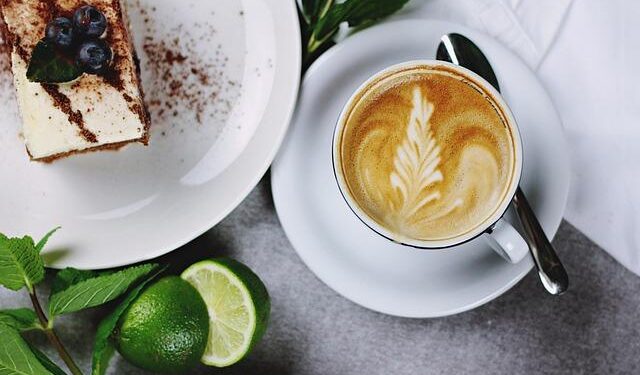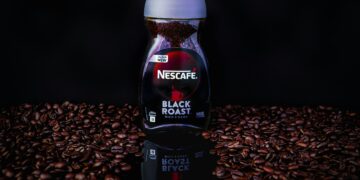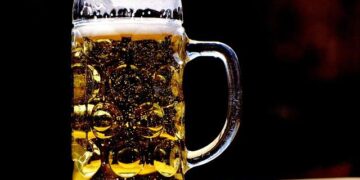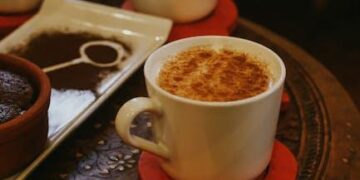Table of Contents
Section 1: Deconstructing “Strong” — The Duality of Flavor and Potency
The term “strong coffee” is a cornerstone of café culture, a request loaded with expectation.
For many, it signifies a beverage capable of cutting through the fog of a slow morning or powering a late-night work session.
Yet, the definition of strength is deeply ambiguous, split between two distinct and often conflicting concepts: the subjective intensity of flavor and the objective potency of caffeine.
At Starbucks, a global titan of coffee, this ambiguity is not just a matter of semantics; it is codified in the menu, marketing, and the very language used to describe its products.
Understanding this duality is the first step toward making truly informed choices and mastering the menu for one’s specific needs.
The common journey of a coffee drinker often begins with a simple, intuitive assumption: a coffee that tastes strong must be strong.
This leads many to chase the boldest, most intense flavors in pursuit of the greatest caffeine kick, a path that can lead to frustrating and counterintuitive results.
1.1 The Language of Strength
Starbucks has meticulously crafted a “roast spectrum” that guides customers through its offerings, classifying coffees into three main profiles: Blonde, Medium, and Dark.1
The language used to describe these profiles is instrumental in shaping consumer perception.
- Starbucks® Blonde Roast: Positioned at the lightest end of the spectrum, this roast is described with words like “lighter-bodied,” “mellow,” “approachable,” and “soft”.1 These descriptors suggest a gentle, less intense experience.
- Medium Roast: Occupying the middle ground, this profile, which includes the flagship Pike Place® Roast, is characterized as “smooth and balanced” with “rich, approachable flavors”.1 The language implies a reliable, middle-of-the-road character.
- Dark Roast: At the other end of the spectrum, these coffees are consistently marketed with powerful, evocative terms. They are described as having a “fuller body,” with “robust, bold taste” and the “characteristic essence of an intense roast”.1
This carefully chosen vocabulary creates a clear sensory hierarchy in the mind of the consumer.
The words “bold,” “robust,” and “intense” are inextricably linked with the idea of power and efficacy.
When a customer is tired and in need of a potent solution, their attention is naturally drawn to the option that sounds the most powerful, establishing the foundation of a widespread coffee myth.
1.2 The Consumer’s Dilemma: Chasing Flavor or Fuel?
The consequence of this marketing language is a common behavioral pattern.
A consumer seeking maximum caffeine—the “fuel” aspect of coffee—will often select the drink that promises the most intense flavor.
This choice is based on the logical, yet flawed, assumption that a gustier, more bitter taste is an indicator of a higher caffeine content.7
The experience of forcing down a Venti Dark Roast, enduring its “punishingly bold” flavor in the belief that it is the most potent option available, is a familiar one for many students, night-shift workers, and sleep-deprived parents.
This behavior is reinforced by a powerful feedback loop.
Starbucks uses descriptors like “bold” because they accurately describe the flavor profile developed through a longer, more intense roasting process.
Consumers, in turn, interpret “bold” as a proxy for caffeine potency.
Their purchasing decisions, based on this interpretation, signal to the company that this language is effective.
This cycle perpetuates the myth, entrenching the connection between dark, bitter flavors and caffeine strength, even when the objective data tells a completely different story.
The result is a well-intentioned consumer making a confident but potentially suboptimal choice, selecting a beverage for its perceived potency while unknowingly sacrificing the very caffeine they seek.
1.3 Introducing the Potency Paradox
The disconnect between perceived strength and actual potency can be termed the “Potency Paradox.” It is most starkly illustrated by a direct comparison of the caffeine content in Starbucks’ brewed coffees.
According to the company’s own nutritional information, the coffee described as “mellow” and “light” is, in fact, the most powerful caffeinated beverage on the menu.
A standard Venti (20 oz) Starbucks® Blonde Roast contains a staggering 475 mg of caffeine.
In stark contrast, a Venti Dark Roast, the beverage marketed as “bold” and “robust,” contains 340 mg.9
This means the “mellow” coffee is nearly 40% more potent than its “bold” counterpart.
This single data point shatters the common perception and raises the central question that this analysis seeks to answer: Why is the gentlest-tasting coffee the most powerful? The answer lies not in the flavor, but in the fundamental science of how coffee is roasted and measured.
To visualize this paradox, the following table places the official flavor descriptors directly alongside the objective caffeine data.
Table 1: The Flavor vs. Potency Matrix
| Roast Profile | Starbucks Flavor Descriptor | Caffeine Content (Grande, 16 oz) |
| Blonde Roast | “Lighter-bodied and mellow” 3 | 360 mg 9 |
| Pike Place® Roast (Medium) | “Smooth and balanced” 1 | 310 mg 9 |
| Dark Roast | “Fuller body with robust, bold taste” 1 | 260 mg 9 |
This table makes the abstract concept of the Potency Paradox concrete and irrefutable.
The inverse relationship between the intensity of the flavor description and the actual caffeine dose is laid bare, priming the reader for the scientific explanation that resolves this apparent contradiction.
Section 2: The Science of the Roast: How Roasting Rewrites the Rules of Caffeine
To understand why a lighter roast at Starbucks yields more caffeine, one must look past the marketing and into the alchemy of the roasting process itself.
The journey a coffee bean takes from a raw, green seed to the fragrant, brown gem ready for grinding involves a series of dramatic physical and chemical transformations.
It is within these transformations that the secret to the Potency Paradox is found, revealing that the ultimate caffeine content in a cup is a function of physics and measurement, not flavor.
2.1 The Journey from Green Bean to Roasted Gem
Coffee roasting is a heating process that turns raw, green coffee beans, which have a grassy, vegetal aroma, into the complex and aromatic product we recognize.2
During this process, hundreds of chemical reactions occur, developing the characteristic flavors and aromas of coffee.
A crucial point, however, is the stability of the caffeine molecule.
Caffeine is a remarkably stable alkaloid at the temperatures typically used in coffee roasting, which rarely exceed 470°F (about 243°C).11
Significant degradation or “burning off” of caffeine would require much higher temperatures, well outside the normal range of any roast profile.11
Therefore, the total amount of caffeine contained within a single coffee bean remains virtually unchanged, regardless of whether it is lightly roasted for a Blonde blend or taken to a much darker state for an Italian or French Roast.
The myth that darker roasts are less caffeinated because the caffeine has been “roasted away” is scientifically unfounded.
The key to the caffeine difference lies not in the destruction of caffeine, but in the transformation of everything else in the bean.
2.2 The Great Deception: Mass vs. Volume
As coffee beans are heated, they undergo two critical physical changes that alter their properties.
First, they lose Mass. This is primarily due to the evaporation of water, which makes up about 10-12% of a green coffee bean’s weight.11
The longer the roast, the more water is lost, and the lighter the individual bean becomes.
Second, the beans increase in volume.
As water turns to steam and gases are released inside the bean, it expands and “puffs up,” much like popcorn.14
This effect also becomes more pronounced with longer roasting times.
These two simultaneous processes—losing mass and gaining volume—are the key to the entire puzzle.
This leads to a clear physical distinction between roast levels:
- Light Roast Beans (e.g., Blonde Roast): Having been roasted for a shorter duration, they have lost less water, retaining more of their original mass. They have also expanded less, resulting in beans that are smaller and denser than their dark-roasted counterparts.13
- Dark Roast Beans: Roasted for a longer period, they have lost more mass and have expanded significantly. The resulting beans are larger, lighter, and less dense.11
2.3 A Tale of Two Measures: The Scoop vs. The Scale
The physical differences between light and dark roast beans become critically important at the moment of measurement, before brewing.
The amount of caffeine in the final cup depends entirely on whether the coffee grounds are measured by volume (with a scoop) or by weight (with a scale).13
- Brewing by Volume (The Scoop Method): This is the most common method for home brewers and is the most practical for high-volume batch brewing in a café setting. When one measures coffee with a scoop, they are taking a fixed volume of grounds. Because light roast beans are smaller and denser, more of them (or more mass of ground particles) will fit into that scoop compared to the larger, less dense dark roast grounds.14 Since each bean contains roughly the same amount of caffeine, the scoop with more bean mass—the light roast—will yield a more caffeinated cup.
- Brewing by Weight (The Scale Method): This method is favored by specialty coffee shops and meticulous home enthusiasts for its precision. When one measures coffee by weight—for example, 20 grams for a pour-over—the outcome is reversed. Because individual dark roast beans are lighter, it takes more of them to reach the target weight of 20 grams compared to the heavier light roast beans.11 In this scenario, the weighed-out portion of dark roast contains more beans, and therefore more caffeine, than the same weight of light roast.
This scientific principle directly explains the caffeine hierarchy at Starbucks.
The hard data shows that the Blonde Roast, a light roast, consistently has the most caffeine of any brewed coffee on the menu.9
From this, one can deduce the operational process that creates this result.
In the fast-paced environment of a Starbucks store, consistency and speed are paramount for preparing large batches of filter coffee.
Measuring grounds for each batch with a standardized scoop is far more efficient than weighing them on a scale.16
This operational choice to brew by volume, when combined with the fundamental physics of roasted coffee beans, inevitably leads to the Blonde Roast yielding a more potent brew.
The strongest coffee on the menu is not a deliberate formulation for potency, but rather an emergent property of a workflow optimized for efficiency.
Section 3: The Official Starbucks Caffeine Ledger: A Quantitative Analysis
While the science explains the “why,” the data provides the “what.” A quantitative analysis of Starbucks’ menu reveals a clear hierarchy of caffeine content across its beverage portfolio.
This section serves as a definitive ledger, ranking the most potent hot and cold drinks by their total caffeine dose and exploring the crucial difference between a large, sustained dose and a concentrated, rapid one.
For the consumer aiming to strategically manage their energy, this data is the ultimate toolkit.
3.1 The Champions of Heat: Ranking Hot Drinks
When it comes to hot beverages, the simple, batch-brewed filter coffees reign supreme, dwarfing their more complex espresso-based cousins in sheer caffeine payload.
The undisputed champion is the Venti (20 oz) Blonde Roast, which delivers a formidable 475 mg of caffeine.17
This single beverage exceeds the U.S. Food and Drug Administration’s recommended daily limit of 400 mg for a healthy adult.19
Following in second place is the Venti
Pike Place® Roast (Medium Roast) at 410 mg, which also surpasses the daily guideline.9
The Venti
Dark Roast, despite its bold flavor, comes in third with a still-potent 340 mg of caffeine.9
Espresso-based drinks present a different profile.
While a single shot of espresso is highly concentrated, the total caffeine in a standard latte, cappuccino, or macchiato is significantly lower.
A Grande (16 oz) of any of these drinks typically contains two shots of espresso, for a total of about 150 mg of caffeine (based on ~75 mg per shot).9
However, the customizable nature of espresso allows for higher doses.
A
Caffè Americano, which is simply espresso shots diluted with hot water, contains four shots in a Venti size, bringing its total to approximately 300 mg.19
A customer can also order a
Quad Espresso straight, receiving four shots for the same 300 mg dose in a much smaller volume.18
3.2 The Kings of Cold: Ranking Chilled Beverages
On the cold side of the menu, the brewing method plays a larger role in determining caffeine content.
The slow, 20-hour steeping process for cold brew results in a smooth but highly caffeinated concentrate.17
The most caffeinated cold drink available is the Trenta (31 oz) Cold Brew, which contains 360 mg of caffeine.17
The Venti (24 oz) version is also a strong contender at
310 mg.9
Nitro Cold Brew, which is infused with nitrogen for a creamy texture, is also highly potent but is not served in sizes larger than a Grande (16 oz) due to the way it’s dispensed.17
A Grande Nitro Cold Brew contains
280 mg of caffeine.19
Shaken espresso drinks, particularly those made with Blonde espresso, have emerged as powerful options.
The Venti Iced Brown Sugar Oatmilk Shaken Espresso, for example, contains three shots of Blonde espresso, pushing its caffeine content to 255 mg.20
(Some sources report an even higher number, suggesting potential variations in recipes or data reporting 17).
Standard
Iced Coffee, which is brewed hot and then chilled, contains less caffeine than its cold-brewed counterpart, with a Trenta size providing 285 mg.9
3.3 The Concentration Game: Caffeine per Ounce
Ranking drinks by total caffeine provides a measure of endurance—the total fuel available in the tank.
However, it doesn’t capture the subjective feeling of a “jolt” or “kick.” For that, one must consider the concentration, or dose density, measured in milligrams of caffeine per fluid ounce (mg/floz).
This analysis reveals a different hierarchy of strength.
- An espresso shot is the king of concentration. A single shot delivers approximately 75 mg in about one fluid ounce, for a dose density of roughly 75 mg/fl oz.18 This is why a small espresso can feel so potent; it delivers a highly concentrated dose very quickly.
- A Venti Blonde Roast, despite having the highest total caffeine (475 mg), delivers it in a 20 oz serving. Its concentration is therefore 475÷20, or 23.75 mg/fl oz.21
This distinction is critical for strategic caffeine consumption.
For a rapid, sharp kick to initiate focus, the high-density dose of an espresso is most effective.
For the highest total dose to sustain energy over several hours, the lower-density but high-volume brewed coffee is the superior choice.
The “strongest” drink depends on whether the goal is immediate impact or long-term endurance.
Table 2: The Ultimate Starbucks Caffeine Reference Guide (Ranked by Total Caffeine)
This table consolidates data from across the menu to provide a practical, at-a-glance reference for consumers seeking to maximize their caffeine intake.
It is sorted by the highest available caffeine dose in a standard menu size.
| Rank | Drink Name | Category | Size | Caffeine (mg) |
| 1 | Blonde Roast | Hot | Venti (20 oz) | 475 17 |
| 2 | Pike Place® Roast | Hot | Venti (20 oz) | 410 17 |
| 3 | Trenta Cold Brew | Cold | Trenta (31 oz) | 360 17 |
| 4 | Dark Roast | Hot | Venti (20 oz) | 340 9 |
| 5 | Venti Cold Brew | Cold | Venti (24 oz) | 310 9 |
| 6 | Caffè Americano | Hot | Venti (20 oz) | 300 19 |
| 7 | Quad Espresso | Hot | Quad (4 oz) | 300 18 |
| 8 | Nitro Cold Brew | Cold | Grande (16 oz) | 280 19 |
| 9 | Trenta Iced Coffee | Cold | Trenta (31 oz) | 285 9 |
| 10 | Iced Brown Sugar Oatmilk Shaken Espresso | Cold | Venti (20 oz) | 255 20 |
| 11 | Flat White | Hot | Grande (16 oz) | 195 18 |
| 12 | Caffè Mocha | Hot | Grande (16 oz) | 175 9 |
| 13 | Blonde Vanilla Latte | Hot | Grande (16 oz) | 170 20 |
| 14 | Iced Coffee | Cold | Grande (16 oz) | 165 9 |
| 15 | Caffè Latte / Cappuccino / Macchiato | Hot | Grande (16 oz) | 150 9 |
Section 4: Hacking the Menu: A Strategist’s Guide to Maximum Potency
Understanding the principles of caffeine content and the official data is the foundation of knowledge.
Applying that knowledge to manipulate the menu is the beginning of mastery.
For the consumer truly dedicated to optimizing their caffeine intake, the standard menu is not a fixed list of options but a palette of ingredients.
By learning a few key customization strategies, or “hacks,” it is possible to create beverages far more potent than anything listed on the board.
4.1 The “Red Eye” and Beyond: Adding Potency to Any Drink
The most direct way to increase the caffeine content of any drink is to add espresso shots.
This practice is well-known in coffee culture and has its own lexicon.
Adding one shot of espresso to a cup of brewed coffee is commonly called a “Red Eye.” Adding two shots is a “Black Eye,” and some adventurous souls may even order a “Green Eye” with three shots.
This simple customization dramatically alters the caffeine calculus.
Consider the most potent standard beverage, the Venti Blonde Roast, which already contains 475 mg of caffeine.
- Ordering a Venti Blonde Roast with one added shot of espresso (a “Red Eye”) combines the base 475 mg with the shot’s ~75 mg, resulting in a beverage with approximately 550 mg of caffeine.17
This single modification creates a drink that is over 15% more potent than the strongest item on the standard menu.
It underscores a critical point: the most powerful drink at Starbucks is often one the customer designs themselves.
This strategy can be applied to any beverage, from boosting a Dark Roast to supercharging a Cold Brew, giving the consumer ultimate control over their dose.
4.2 The Blonde Advantage: Requesting a Stronger Base
For those who prefer espresso-based drinks like lattes or cappuccinos, a more subtle but effective hack is to change the foundational ingredient.
Most standard espresso beverages are made with Starbucks’ Signature Espresso Roast.
However, customers can request that their drink be made with the Blonde Espresso Roast instead.17
While the caffeine difference per shot is less dramatic than in brewed coffee, it is still significant.
A shot of Blonde Espresso contains approximately 85 mg of caffeine, compared to the ~75 mg in a shot of Signature Espresso.19
In a drink with multiple shots, this difference becomes meaningful.
For example:
- A standard Venti Caffè Americano contains four shots of Signature Espresso for a total of ~300 mg.
- A Venti Blonde Americano, made with four shots of Blonde Espresso, would contain approximately 4×85 mg, for a total of 340 mg.
This “Blonde Advantage” provides a 40 mg boost without altering the texture or fundamental character of the drink, making it an easy upgrade for any regular espresso drinker seeking extra potency.
4.3 Navigating the Noon Cutoff
One of the most valuable pieces of insider knowledge for fans of the Blonde Roast is understanding its availability.
Due to brewing schedules and demand patterns, many Starbucks locations stop batch-brewing the Blonde Roast around noon.8
A customer arriving in the afternoon seeking the most caffeinated option might be disappointed to find only Pike Place and a Dark Roast available.
However, there is a solution.
A customer can request a pour-over of any coffee bean the store has in stock, including the Blonde Roast, at any time of day.8
While this method takes a few minutes longer than pouring from a pre-brewed batch, it guarantees access to the most potent roast.
Knowing to ask for a “pour-over Blonde” is a key strategy that unlocks the menu’s maximum caffeine potential throughout the entire day.
4.4 A Word of Caution: Know Your Limits
This guide provides the tools to maximize caffeine intake, but with great power comes the need for great responsibility.
It is imperative to contextualize these high caffeine numbers with official health guidelines.
The U.S. Food and Drug Administration (FDA) states that up to 400 milligrams of caffeine per day is an amount not generally associated with dangerous, negative effects for healthy adults.19
It is critical to note that several standard Starbucks beverages, without any modification, exceed this entire daily recommendation in a single serving.
- Venti Blonde Roast: 475 mg
- Venti Pike Place® Roast: 410 mg
Customized drinks, like a “Red Eye” Venti Blonde Roast (550 mg), push this limit even further.
While individual tolerance to caffeine varies, consuming such high doses can lead to adverse effects like restlessness, anxiety, insomnia, headaches, and heart palpitations.18
This information should therefore be used not just as a means to achieve a desired state of alertness, but as a tool for responsible consumption, allowing consumers to understand precisely what they are putting into their bodies and to make choices that align with their personal health and wellness goals.
Works cited
- Finding the Right Roast for You – Starbucks ® coffee, accessed August 6, 2025, https://athome.starbucks.com/learn/finding-right-roast-you
- The Starbucks® Coffee Roast Spectrum, accessed August 6, 2025, https://athome.starbucks.com/learn/coffee-roast-spectrum
- Starbucks Coffee roast spectrum explained – About Starbucks, accessed August 6, 2025, https://about.starbucks.com/stories/2025/starbucks-coffee-roast-spectrum-explained/
- The Starbucks® Roast Spectrum Story, accessed August 6, 2025, https://www.starbucksathome.com/my/story/the-roast-spectrum
- The Starbucks® Roast Spectrum Story, accessed August 6, 2025, https://www.starbucksathome.com/ca/en-ca/story/roast-spectrum
- Dark Roast Coffee – Starbucks® at Home, accessed August 6, 2025, https://athome.starbucks.com/product-category/dark-roast
- How Much Caffeine in Dark Roasts vs Light Roasts? – Detour Coffee Roasters, accessed August 6, 2025, https://detourcoffee.com/blogs/news/how-much-caffeine-in-dark-roasts-vs-light-roasts
- The 20 Drinks At Starbucks With The Most Caffeine – Tasting Table, accessed August 6, 2025, https://www.tastingtable.com/1496483/drinks-starbucks-most-caffeine/
- How Much Caffeine in a Cup of Starbucks Coffee? – CAFELY, accessed August 6, 2025, https://cafely.com/blogs/info/how-much-caffeine-starbucks-coffee
- Coffee Roast Levels: Meaning, Taste, and How To Choose – Colipse, accessed August 6, 2025, https://colipsecoffee.com/blogs/coffee/roast-levels
- Which Has More Caffeine: Light or Dark Roast? – Scribblers Coffee Co., accessed August 6, 2025, https://scribblerscoffee.com/blogs/news/which-has-more-caffeine-light-or-dark-roast
- A Bit About Caffeine – CoffeeGeek, accessed August 6, 2025, https://coffeegeek.com/blog/techniques/a-bit-about-caffeine/
- Which Coffee Has More Caffeine Dark or Light Roast?, accessed August 6, 2025, https://blackcreekcoffee.com/blogs/coffee-talk/which-coffee-has-more-caffeine-dark-or-light-roast
- Does lightly roasted coffee contain more caffeine than dark roasted? – Reddit, accessed August 6, 2025, https://www.reddit.com/r/Coffee/comments/vfvea7/does_lightly_roasted_coffee_contain_more_caffeine/
- WHICH ROAST HAS MORE CAFFEINE? – Kicking Horse Coffee, accessed August 6, 2025, https://kickinghorsecoffee.com/pages/which-roast-has-more-caffeine
- Which Has More Caffeine, Light Roast or Dark Roast Coffee? – YouTube, accessed August 6, 2025, https://www.youtube.com/watch?v=98tpZGeppSw
- 15 Strongest Starbucks Drinks (Ranked by Caffeine) (2023) – Above Average Coffee, accessed August 6, 2025, https://aboveaveragecoffee.com/strongest-starbucks-drinks/
- 24 Popular Starbucks Drinks Ranked By Their Caffeine Content | Lifeboost Coffee, accessed August 6, 2025, https://lifeboostcoffee.com/blogs/lifeboost/starbucks-caffeine-guide-24-popular-drinks-ranked-by-their-caffeine-content
- The strongest coffee at Starbucks: What to order for an extra caffeine kick – The Manual, accessed August 6, 2025, https://www.themanual.com/food-and-drink/strongest-coffee-at-starbucks/
- 21 Most Caffeinated Drinks at Starbucks in 2025 – Cozymeal, accessed August 6, 2025, https://www.cozymeal.com/magazine/most-caffeinated-drink-at-starbucks
- 25 Strongest Starbucks Drinks (For Caffeine Lovers) – Wander Her Way, accessed August 6, 2025, https://www.wanderherway.com/strongest-starbucks-drinks-caffeine-fix/
- Recommend me a high caffeine drink? : r/starbucks – Reddit, accessed August 6, 2025, https://www.reddit.com/r/starbucks/comments/182g2ij/recommend_me_a_high_caffeine_drink/
- What hot drink contains most amount of caffeine? : r/starbucks – Reddit, accessed August 6, 2025, https://www.reddit.com/r/starbucks/comments/1g0w0da/what_hot_drink_contains_most_amount_of_caffeine/






